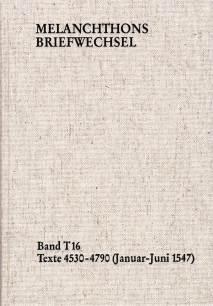Philipp Melanchthon: Band T 16: Texte 4530-4790 (Januar–Juni 1547)
From his exile in Zerbst, Melanchthon witnessed the horrors of the Schmalkaldic War, but was however confident that God would preserve the church and the studies. He derived comfort from the letters he received as well as those he wrote himself. Approximately 240 of the 272 letters and texts contained in this volume were written by Melanchthon. It was in the chaos of war in particular that he believed solidarity among scholars to be of special importance. The news of the death of his daughter, Anna Sabinus, in Königsberg, caused him additional suffering. After the defeat of the electors of Saxony at the Battle of Mühlberg, Melanchthon fled with his family to Nordhausen. A number of universities, cities and rulers offered him asylum and jobs. Before Melanchthon was able to make a decision there were already rumors that the new ruler, Maurice of Saxony, was going to reopen the University of Wittenberg.
Reviews
»Wir lesen einen Band, in dem sehr viel kriegsbedingte und persönliche Nöte im Umfeld Melanchthons besprochen werden. Durch die besondere Lage im Exil hat die Korrespondenz dieser Zeit ein markantes Kolorit.«
»Abschließend sein noch einmal betont, dass wir es hier mit einem faszinierenden Quellenkorpus zu tun haben. [...] Melanchthons Korrespondenz [deckt] seine Stellung in der Gelehrtenrepublik und deren Briefkultur in einem über Jahrzehnte europaweit geknüpften Kommunikationsnetz auf, das zur Verbreitung sowohl seines humanistischen Ideals als auch der reformatorischen Lehre maßgeblich gewirkt hat. Die vielfalt seiner Korrespondenten im Reich und überall in Europa zeugt in diesen zwei weiteren Bänden [T 15 und T 16] erneut von seiner Schlüsselrolle in der Reformation seit ihrem Beginn 1517.«
All volumes
- Band T 1: Texte 1-254 (1514–1522) – available
- Band T 2: Texte 255-520 (1523–1526) – available
- Band T 3: Texte 521-858 (1527–1529) – available
- Band T 4,1-2: Texte 859-1109 (1530) – available
- Band T 5: Texte 1110-1394 (1531–1533) – available
- Band T 6: Texte 1395-1683 (1534–1535) – available
- Band T 7: Texte 1684-1979 (1536–1537) – available
- Band T 8: Texte 1980-2335 (1538–1539) – available
- Band T 9: Texte 2336-2604 (1540) – available
- Band T 10: Texte 2605-2865 (1541) – available
- Band T 11: Texte 2866-3126 (1542) – available
- Band T 12: Texte 3127-3420a (1543) – available
- Band T 13: Texte 3421-3779 (1544) – available
- Band T 14: Texte 3780-4109 (1545) – available
- Band T 15: Texte 4110-4529a (1546) – available
- Band T 16: Texte 4530-4790 (Januar–Juni 1547) – available
- Band T 17: Texte 4791-5010 (Juli–Dezember 1547) – available
- Band T 18: Texte 5011-5343 (Januar–Oktober 1548) – available
- Band T 19: Texte 5344-5642 (November 1548–September 1549) – available
- Band T 20: Texte 5643-5969 (Oktober 1549–Dezember 1550) – available
- Band T 21: Texte 5970-6291 (1551) – available
- Band T 22: Texte 6292-6690 (1552) – available
- Band T 23: 6691-7093 (Januar 1553-Februar 1554) – available
- Band T 24: Texte 7094-7454 (März 1554-März 1555) – available
- Band T 25: Texte 7455–7802 (April 1555–April 1556) – November 2024
- Band T 26: Texte 7803–8142 (Mai 1556–Februar 1557) – Second half of 2025
- Band T 27: Texte 8143–8472 (März–Dezember 1557) – in preparation
- Band T 28 – in preparation
- Band T 29 – in preparation
- Band T 30 – in preparation
- Subject Areas
- New Publications
- ---
- Critical Editions
- Abaelardus: Dialogus
- Andreae: Gesammelte Schriften
- Arnauld / Nicole: L'Art de Penser
- Böhme: Die Urschriften
- Böhme: Gesamtausgabe
- Bolzano: Gesamtausgabe
- Droysen: Historik
- Fichte: Gesamtausgabe
- Fischart: Sämtliche Werke
- Franck: Sämtliche Werke
- Frischlin: Sämtliche Werke
- Hülser: Die Fragmente zur Dialektik der Stoiker
- Harnack: Einleitung in das neue Testament
- Hauptmann: Sämtliche Werke
- Hegel: Vorlesungen über Rechtsphilosophie 1818-1831
- Herder: Studien und Entwürfe
- Jacobi: Briefwechsel - Nachlaß - Dokumente
- Locke: Anleitung des menschlichen Verstandes
- Maimon: Gesamtausgabe
- Meier: Beyträge
- Melanchthon: Briefwechsel
- Mendelssohn: Gesammelte Schriften
- Nicolai: Sämtliche Werke – Briefe – Dokumente
- Reinhold: Korrespondenzausgabe
- Reuchlin: Briefwechsel
- Reuchlin: Sämtliche Werke
- Scaliger: Poetices libri septem
- Schelling: Historisch-kritische Ausgabe
- Schickard: Briefwechsel
- Shaftesbury (Anthony Ashley Cooper): Standard Edition
- Steiner: Schriften
- Svarez: Gesammelte Schriften
- Thomas von Aquin: De Unione
- Weigel: Sämtliche Schriften. Neue Edition
- Collected Works
- Series
- Bibliographies and Reference Books
- Allgemeine Zeitschrift für Philosophie
- AZP Beihefte
- Jahrbuch der Psychoanalyse
- JP Beihefte
- Steiner Studies
- Open-Access
- Single volumes
- eBooks
- Special Offers
- ---
- Authors
- Publishing house
- Links / Partner
- Paths to Philosophy
